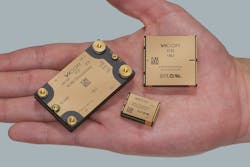Is the Automotive Industry Ready for Modular Powertrains and 48-V Batteries?
This article is part of the TechXchange: EV Battery Management.
What you’ll learn:
- How EV automakers are taking a page from their modularized automotive infotainment systems and applying that to the powertrain.
- Why a move to 48-V batteries will help EV designers save vehicle weight while improving power efficiency and reducing power losses.
Automotive technology roadmaps are notoriously difficult to predict given the automotive industry’s lengthy and involved design cycles. Unlike other purchases, car ownership is an expensive, long-term commitment that reinforces a methodical, rigid mindset when it comes to the industry’s approach to risk taking and bleeding-edge innovation.
That said, we see two electrification trends taking place over the next three to five years: Increasing usage of modular power and the inexorable adoption of 48-V battery technology. Both are driven by OEMs racing to electrify their fleets.
Going Modular
Let’s examine each trend. Modular designs can reduce development complexity, simplify supply-chain management and inventory carrying costs, and accelerate time to revenue. If your automotive entertainment system fails, for example, the dealership doesn’t send for a radio repairman. They dismantle the center stack and replace the entire head-end unit.
With the biggest car companies releasing as many as 15 different models over a given three-year span, the transition to interchangeable designs is here to stay.
Power and powertrain engineers have begun lifting a page from this playbook as a means of repurposing the same core design across multiple vehicle platforms with different features and price points. This is becoming more apparent as the proportion of the vehicle served by electronic systems rises from roughly 34% today to better than 50% in the next few years.
High-density power modules, for example, help reduce packaging space and weight and therefore can enhance range. And that shift will be driven by yet more modular technologies, among them steer-by-wire and brake-by-wire, which run off the electrical system, not the alternator. These replace mechanical components with a battery, wired control box, and an actuator.
It helps explain why the Big Three U.S. car makers pledged $100 billion last year on new vehicle platforms, even as they let go of thousands of mechanical engineers and continue desperately hunting for electrical engineers and electrification experts to take their place.
Rise of the 48-V Battery
The auto industry’s love affair with the ubiquitous 12-V battery shows no signs of flaming out. Many car and truck owners, for instance, have unwittingly benefited this past winter from the brute cold-crank performance of a 12-V lead-acid battery. Its chemistry ensures the vehicle will turn over in frigid conditions in a way that 48-V lithium-ion batteries cannot. Even so, the rationale for augmenting certain applications with a 48-V replacement continues to gain ground.
In recent years, we’ve seen 48-V battery adoption beginning to climb, particularly in smaller auxiliary components such as fans, blowers, and chillers. Or take active suspension, a sophisticated piece of electronic circuitry that compensates for weight shift in a vehicle.
The duty cycle on these systems is extremely low when you’re driving at 60 mph on a highway, but when you take an exit ramp, the weight shifts and the active suspension can source enough current to drive power levels to a 4- or 5-kW peak. Doing that on a 12-V battery requires an enormous slug of current, plus the attendant wiring and harnessing. The same holds true for water pumps, where a 12-V supply may require as much as nine meters of cable due to factors such as stray field immunity, seepage, clearance, and electromagnetic interference.
This tilts many new and emerging car subsystems in favor of 48-V batteries, whose 23 grams of cable weighs as little as 10% that of a 12-V alternative. The bus that moves 48 V throughout the vehicle can be achieved with thinner, lighter wire harnesses and cabling, reducing weight and enhancing range.
OEMs are now focused on reducing the weight of the wire harness in a car, which can exceed 150 pounds, and could be reduced significantly just by swapping to lighter 48-V cable. That said, the economics and sheer level of investment required to retool the factory floor from 12 to 48 V remains daunting for many car manufacturers, Tier 1 suppliers, and component makers, which have built their entire power infrastructure around an older technology that they continue to cost-reduce.
Nevertheless, better efficiency and reduction of power losses makes an undeniable case for moving to power modules and bussing at 48 V. The 12-V status quo will soon have company, and those automotive manufacturers who refuse to respond will pay a heavy price somewhere down the road.
Read more articles in the TechXchange: EV Battery Management.
About the Author
Patrick Wadden
Global Vice President Automotive Business Unit, Vicor Corp.
Patrick Wadden joined Vicor Corp. in 2018 as Global Vice President, Automotive Business Unit, where he’s responsible for developing and coordinating Vicor’s business in the global automotive market. Prior to joining Vicor, Mr. Wadden led North American sales in the automotive segment for Integrated Device Technology. His prior experience includes leadership roles in sales, marketing, and product line management for Analog Devices, Altera, and Intersil. Mr. Wadden holds a BSBA from Northeastern University.


